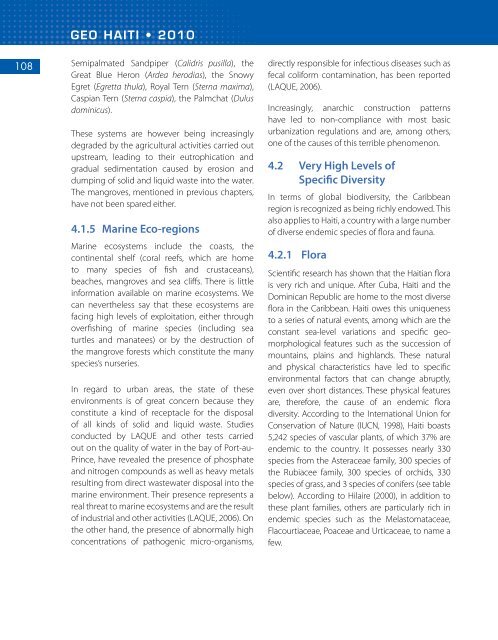GEO Haiti 2010
GEO Haiti 2010
GEO Haiti 2010
Create successful ePaper yourself
Turn your PDF publications into a flip-book with our unique Google optimized e-Paper software.
<strong>GEO</strong> HAITI • <strong>2010</strong><br />
108<br />
Semipalmated Sandpiper (Calidris pusilla), the<br />
Great Blue Heron (Ardea herodias), the Snowy<br />
Egret (Egretta thula), Royal Tern (Sterna maxima),<br />
Caspian Tern (Sterna caspia), the Palmchat (Dulus<br />
dominicus).<br />
These systems are however being increasingly<br />
degraded by the agricultural activities carried out<br />
upstream, leading to their eutrophication and<br />
gradual sedimentation caused by erosion and<br />
dumping of solid and liquid waste into the water.<br />
The mangroves, mentioned in previous chapters,<br />
have not been spared either.<br />
4.1.5 Marine Eco-regions<br />
Marine ecosystems include the coasts, the<br />
continental shelf (coral reefs, which are home<br />
to many species of fish and crustaceans),<br />
beaches, mangroves and sea cliffs. There is little<br />
information available on marine ecosystems. We<br />
can nevertheless say that these ecosystems are<br />
facing high levels of exploitation, either through<br />
overfishing of marine species (including sea<br />
turtles and manatees) or by the destruction of<br />
the mangrove forests which constitute the many<br />
species’s nurseries.<br />
In regard to urban areas, the state of these<br />
environments is of great concern because they<br />
constitute a kind of receptacle for the disposal<br />
of all kinds of solid and liquid waste. Studies<br />
conducted by LAQUE and other tests carried<br />
out on the quality of water in the bay of Port-au-<br />
Prince, have revealed the presence of phosphate<br />
and nitrogen compounds as well as heavy metals<br />
resulting from direct wastewater disposal into the<br />
marine environment. Their presence represents a<br />
real threat to marine ecosystems and are the result<br />
of industrial and other activities (LAQUE, 2006). On<br />
the other hand, the presence of abnormally high<br />
concentrations of pathogenic micro-organisms,<br />
directly responsible for infectious diseases such as<br />
fecal coliform contamination, has been reported<br />
(LAQUE, 2006).<br />
Increasingly, anarchic construction patterns<br />
have led to non-compliance with most basic<br />
urbanization regulations and are, among others,<br />
one of the causes of this terrible phenomenon.<br />
4.2 Very High Levels of<br />
Specific Diversity<br />
In terms of global biodiversity, the Caribbean<br />
region is recognized as being richly endowed. This<br />
also applies to <strong>Haiti</strong>, a country with a large number<br />
of diverse endemic species of flora and fauna.<br />
4.2.1 Flora<br />
Scientific research has shown that the <strong>Haiti</strong>an flora<br />
is very rich and unique. After Cuba, <strong>Haiti</strong> and the<br />
Dominican Republic are home to the most diverse<br />
flora in the Caribbean. <strong>Haiti</strong> owes this uniqueness<br />
to a series of natural events, among which are the<br />
constant sea-level variations and specific geomorphological<br />
features such as the succession of<br />
mountains, plains and highlands. These natural<br />
and physical characteristics have led to specific<br />
environmental factors that can change abruptly,<br />
even over short distances. These physical features<br />
are, therefore, the cause of an endemic flora<br />
diversity. According to the International Union for<br />
Conservation of Nature (IUCN, 1998), <strong>Haiti</strong> boasts<br />
5,242 species of vascular plants, of which 37% are<br />
endemic to the country. It possesses nearly 330<br />
species from the Asteraceae family, 300 species of<br />
the Rubiacee family, 300 species of orchids, 330<br />
species of grass, and 3 species of conifers (see table<br />
below). According to Hilaire (2000), in addition to<br />
these plant families, others are particularly rich in<br />
endemic species such as the Melastomataceae,<br />
Flacourtiaceae, Poaceae and Urticaceae, to name a<br />
few.

















